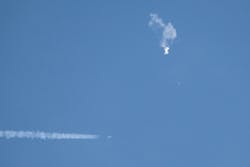U.S. shoots down fourth object as China flings new accusation
The U.S. military had never shot down an object in American airspace before taking out a Chinese balloon off South Carolina earlier this month. Now it’s becoming a near-daily occurrence.
The sudden spate of U.S. jets blasting unidentified objects of mysterious origin from the skies has provoked so much befuddlement — not to mention panic — that Pentagon officials were forced to field questions about the issue Sunday night, just as Americans were tuning into the second quarter of the Super Bowl. One reporter even asked if it was possible the objects-turned-targets were sent by extraterrestrials.
“I haven’t ruled out anything at this point,” said General Glen VanHerck, commander of the North American Aerospace Defense Command.
In reality, the answer is probably more mundane. Officials said they started watching the skies more closely in the days since the alleged Chinese spy balloon traversed U.S. territory, provoking both a national uproar and a new round of tensions with China. That resulted in the U.S. shooting down smaller objects over Alaska on Friday, northern Canada on Saturday, and Michigan on Sunday.
“We have been more closely scrutinizing our airspace at these altitudes, including enhancing our radar, which may at least partly explain the increase in objects that we’ve detected over the past week,” Assistant Secretary of Defense Melissa Dalton told reporters.
The growing number of incidents is raising more questions about the direction of relations between the world’s two largest economies, especially now that the Biden administration is hyper-alert about the threat it says is posed by a global Chinese military-backed surveillance program spanning more than 40 countries — a claim Beijing has rejected.
China also stepped up accusations against the Biden administration, saying on Monday the U.S. sent balloons over its territory more than 10 times since the beginning of 2022. Over the weekend, a Chinese news outlet, The Paper, said China was getting ready to take down an unidentified object flying over its waters near the port city of Qingdao.
“It is nothing rare for U.S. balloons to illegally enter other country’s airspace,” Chinese Foreign Ministry spokesman Wang Wenbin told reporters at a regular briefing in Beijing on Monday. “We reserve the right to take necessary means to deal with relevant incidents.”
National Security Council spokeswoman Adrienne Watson called reports of it using surveillance balloons over China “false” and turned the accusation back on China.
“This is the latest example of China scrambling to do damage control,” she said.
While each incident in the U.S. may have a reasonable explanation, questions persist for the Biden administration. The most immediate: Will the Pentagon send up fighter jets every time it spots some new object — be it a weather balloon, a hobbyist’s craft or a drone — if it potentially threatens civilian aviation or drifts near one of many military sites scattered across the country?
The two officials on the Pentagon conference call with reporters weren’t able to answer that question, with VanHerck calling it a “policy decision.” Dalton acknowledged that researchers and companies send up lots of devices “for purposes that are not nefarious, including legitimate research.”
The inability of U.S. officials to say anything about the sources of the latest three downed objects has spawned theories that they could be balloons relaying signals to China or Russia, an alien object or just airborne junk.
“There is a lot of garbage up there,” Representative Jim Himes, a Connecticut Democrat, said on NBC’s “Meet the Press” on Sunday.
One possibility is that they were nodes in a larger spying enterprise that went undetected before U.S. radars and other sensors were optimized to detect slow-flying objects above 50,000 to 60,000 feet, said Charlie Moore, a retired lieutenant general and former vice director of operations at Norad who teaches at Vanderbilt University.
“Since we’ve seen the development of these balloons over the last couple of years, we’ve had to go back and look at all the sources and methods we might use to detect their launch, monitor their movement and then obviously be able to track them as they approach the United States and Canada,” he said.
U.S. officials have briefed dozens of foreign diplomats on the matter last week and say they will know more once they recover the wreckage of the Chinese balloon, whose payload has been located — but not retrieved — in about 50 feet (15 meters) of water off Myrtle Beach, South Carolina. U.S. and Canadian search crews are also still looking for the three other objects that were shot down.
The episodes have created a new wave of partisan bickering, with Republicans arguing Biden should have shot down the Chinese balloon when it was first spotted over Alaska instead of letting it drift across the country. That has only contributed to the anxiety in Washington about the potential threat posed by China, which has denounced the U.S. for downing what it says was simply a weather balloon that went astray.
“We have probably reached peak media and political frenzy related to the PRC spy balloon,” said Jacob Stokes, a former Obama administration foreign policy adviser who is now at the Center for a New American Security, referring to the People’s Republic of China. “But even when the public attention subsides, the U.S. government will likely be working to respond to this problem for a long time to come.”
____
(With assistance from Katrina Manson, Iain Marlow and Jenny Leonard.)
___
©2023 Bloomberg L.P. Visit bloomberg.com. Distributed by Tribune Content Agency, LLC.
